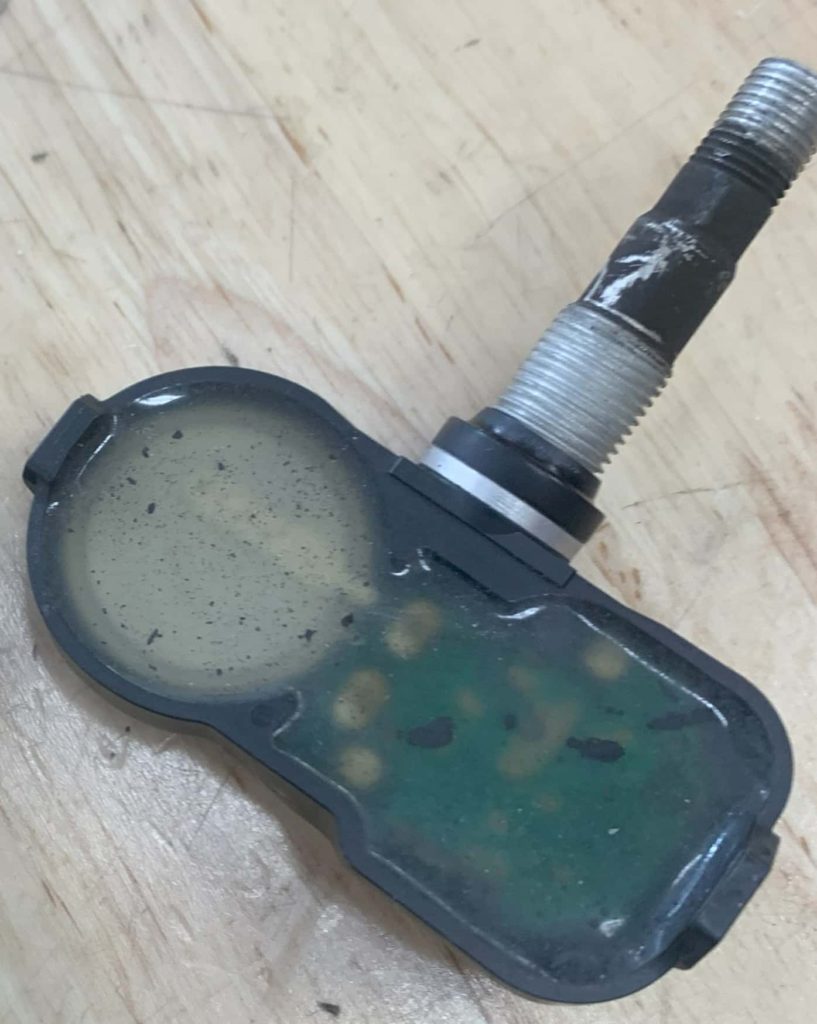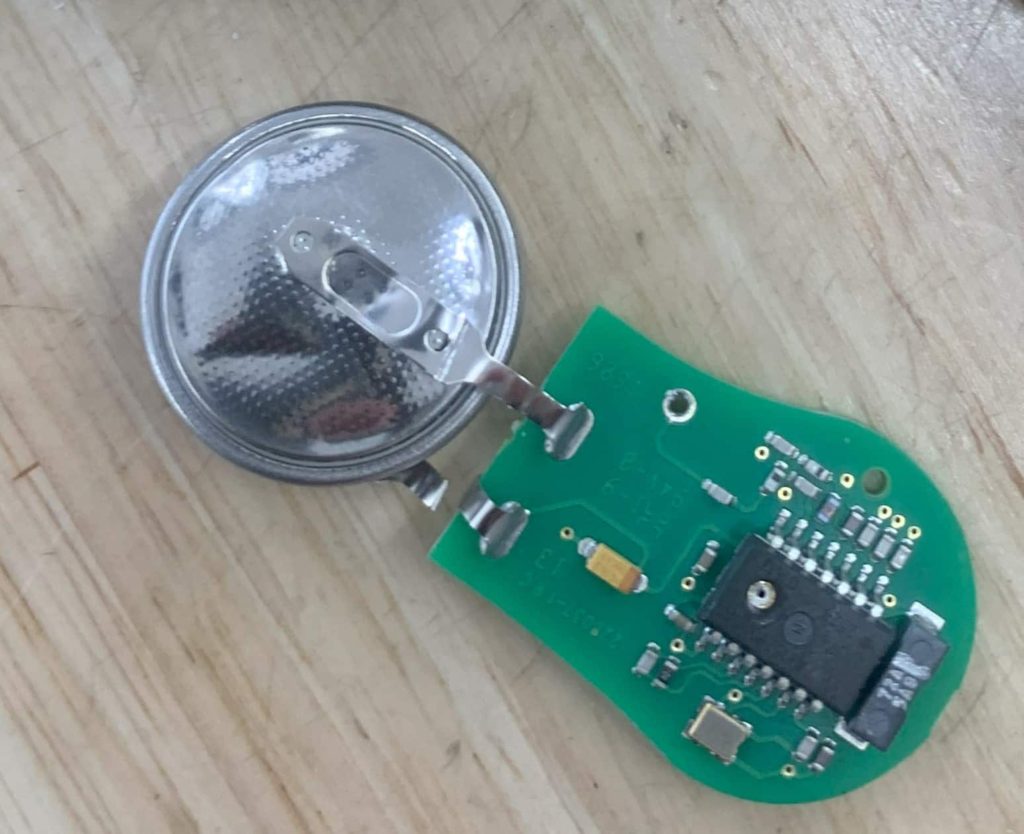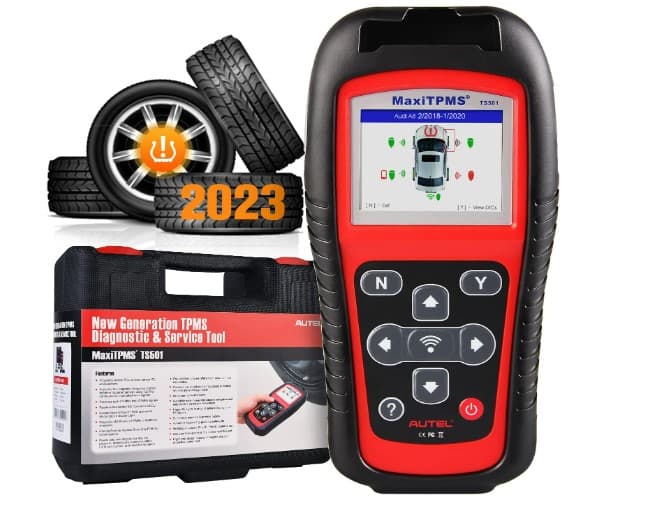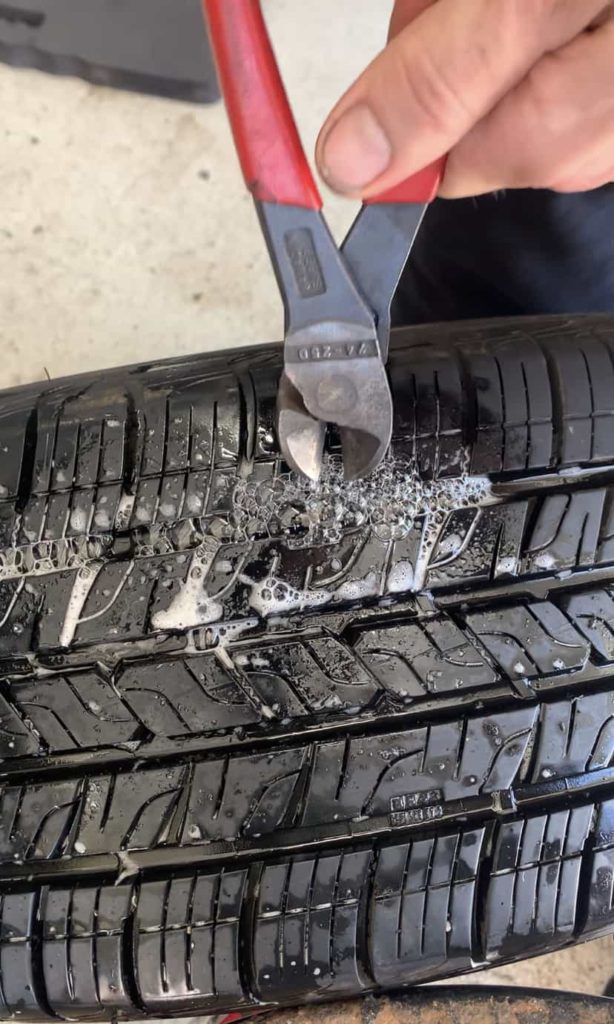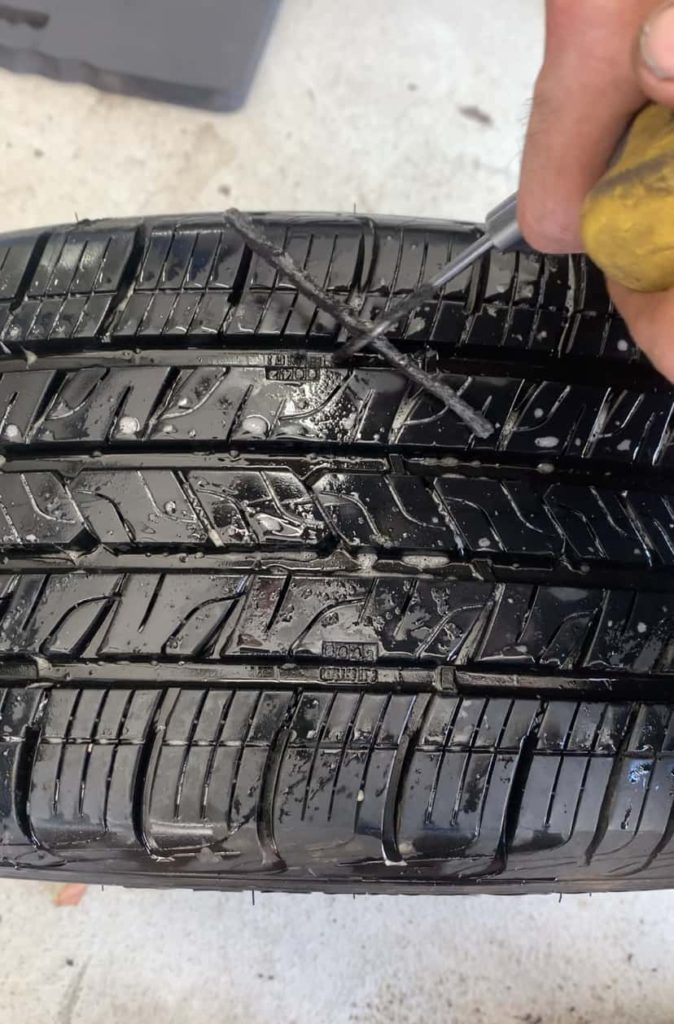What is the Ford Focus TPMS?
The Ford Focus TPMS (tire pressure monitoring system) is a system made up of tire pressure sensors within each tire, a tire pressure receiver module and a main computer known as the ECU. The system works together to alert the driver when there is an issue with one or more tire pressure as well as self diagnosing any issues with the TPMS itself.
How Does the Ford Focus TPMS Work?
The TPMS is a system made up of multiple pieces, this is how they work together:
Tire Pressure and Temperature Monitoring Sensors: Integrated into the base of each valve stem within the tires, sensors actively measure both pressure and temperature once the vehicle exceeds a speed of 20 mph. Each sensor is encased in a small plastic housing and equipped with its own circuit board, these sensors operate via battery-powered transmitters.
Wireless Data Relay: As the Ford Focus is in motion or whenever there’s a change in tire conditions, the sensors wirelessly transmit the collected data. They utilize either 315 MHz or 433 MHz frequencies to send the data using Radio Frequency (RF) transmission.
TPMS Receiving Unit: Positioned within the Focus is an auxiliary circuit board or microcomputer responsible for intercepting the wireless signals emitted by the tire sensors. This unit then relays the consolidated information to the vehicle’s ECU for further analysis.
Ford Focus ECU: The Electronic Control Unit (ECU) acts as the main computing center of the Ford Focus. It scrutinizes the incoming data related to tire pressure and temperature and compares them against Ford’s preset standards for the car. Should the tire pressure fall 15-20% or more below the recommended level, a low tire warning is activated.
Dashboard Alerts for Tire Pressure: When the ECU identifies a tire pressure that’s below the safe threshold, a yellow exclamation mark warning light turns on.
How to Reset the Ford focus Tire Light
Park the Ford Focus on level ground.
Check and adjust the tire pressures of all 4 tires when they are cold. Set the pressures to the exact recommended values.
Drive the Ford Focus for at least a few minutes while moving over 20 Mph.
How to Re-Train the Ford Focus Tire Pressure Sensors
Turn Off the Engine: Turn the ignition and power to the Ford Focus OFF.
Activate Electrical Systems: Press the ignition button twice without using the brake pedal, or turn the key to the ACC setting, thereby powering the vehicle’s electrical system while the engine remains off.
Operate Hazard Lights: Cycle the hazard flasher lights on and off for a total of three cycles, equaling six presses of the button. On-Off, On-Off, On-Off.
Initiate Reset Mode: If you’ve followed steps 1-3 properly, a single horn beep and a display notification should indicate that you’ve entered “RESET MODE.”
Driver’s Front Tire: Step out of the vehicle and unscrew the valve cap from the front left wheel.
Deflate Driver’s Front Tire: Press the valve core to release air until a horn sound confirms the tire’s position has been submitted to the ECU.
Passenger’s Front Tire: Walk over to the front right tire and remove the valve cap, then start deflating it until the horn sounds again.
Passenger’s Rear Tire: Move to the back right tire, take off the valve cap, and release air until a horn beep is heard.
Driver’s Rear Tire: Lastly, go to the rear left tire, remove the valve cap, and deflate the tire until the horn indicates success.
Completion Confirmation: A “Training Complete” message should appear on the display if all steps have been carried out successfully.
Power Off: Cycle the Focus’s power Off and thenOn.
Pump Tires: Inflate all the tires back to their specified pressure levels and put the valve caps back on!
Evaluation Drive: Drive the Ford Focus for a few minutes, ensuring to maintain speeds above 20 mph.
g
Tire Pressure Sensor Re-Training Tips
🔎 Only follow this process in the following order: Front left tire, front right tire, rear left tire, rear right tire.
🔎 If you hear the horn double beep, start the process again.
Ford Focus Tire Pressures
TIRE SIZE | FRONT PSI | REAR PSI |
195/65R15 | 35 | 35 |
215/50R17 | 35 | 35 |
225/50R17 | 38 | 38 |
235/40R18 | 36 | 36 |
215/55R16 | 35 | 35 |
What Can Trigger the Ford Focus Tire Pressure Light to Turn On?
Underinflated tires
Tires filled beyond recommended levels
Wheels or tires leaking air
Missing TPMS pressure sensor (such as when utilizing the spare)
Depleted or dysfunctional sensor battery
Compromised TPMS receiver module or ECU
Interference from surrounding electronics or Ford cars
Fluctuations in ambient conditions or altitude
Vehicle carrying or towing an overweight load
Extreme window tints
Ford Focus Tire Pressure sensor Batteries
Every Ford Focus wheel comes with a tire pressure sensor that runs on a specialized silver-oxide battery (excluding the spare tire). This sensor has an electronic circuit board that is hardwired to the battery and resides in a plastic case. The design makes it impossible to only replace the battery; the entire sensor and valve stem has to be swapped for a new one. On average, the lifespan of Ford’s tire pressure sensors varies between 5 to 10 years or roughly up to 100,000 miles.
Troubleshooting the Ford Focus Tire Pressure Light
If the tire pressure light on your Ford Focus didn’t go off or reset after trying to reset it, here are six potential fixes to help you identify and solve the problem.
Solution 1: Is a Tire Leaking Air Pressure?
Should the tire light illuminate on your Ford Focus, your immediate action should be to cease driving and inspect the tire. Examine each tire and assess their pressures to identify the one with insufficient air. To determine if your Ford Focus tire has a leak, take the following steps:
Measure the air pressure in all tires to locate the one that is underinflated.
Add air to the low tire with a tire inflator.
Drive the Focus at speeds above 20 mph for a few minutes.
Answer: If the tire light deactivates after you’ve inflated the tire and driven the car for a bit, but comes back on later (be it minutes, hours, or days), it’s a strong indication that there is a leak in that specific tire or wheel. To pinpoint the exact location of the leak, refer to solution 6.
Solution 2: Clearing the Diagnostic Trouble Codes From the Ford Focus ECU
The Electronic Control Unit (ECU) in the Ford Focus logs each instance when the low tire pressure light activates, storing it as a diagnostic trouble code (DTC). This method of turning off the TPMS light is akin to rebooting your computer to clear temporary glitches. To “reset” your Ford Focus computer, you’ll need to disconnect the power to the ECU. Achieve this by detaching the negative terminal of the primary 12-volt battery (ensure the ignition and all electronics are turned off), waiting briefly, and then reattaching it. Once the car’s power is restored, we suggest driving it at a steady 50 mph for about 30 minutes.
Answer: If the tire pressure light goes off after performing these steps but reactivates during or after driving, this could indicate either malfunctioning tire pressure sensors due to battery issues or an existing leak in one or multiple tires or wheels.
Solution 3: Using a TPMS Diagnostic Tool
If the tire light activates and displays a message such as “Tire Pressure Sensor Fault”, “Tire Pressure Monitor Fault,” or the yellow tire light is flashing, it indicates that one or more of the tire pressure sensors are malfunctioning. To identify the faulty sensor, you can utilize a TPMS diagnostic device.
Plug the diagnostic device into the Ford Focus’s OBD2 port.
Position the TPMS tool right in front of the valve stem of the front left tire and choose the “test” or “trigger” option on the device.
Await the device’s response before proceeding to test the remaining three tires.
Answer: Once all Ford Focus TPMS sensors have been examined, the diagnostic tool will generate a status report for each. If the device fails to connect with a sensor or reports a low or exhausted battery, the affected sensor needs to be replaced.
Solution 4: Activate a Dormant Tire Pressure Sensor
At times, tire pressure sensors can be quite unresponsive and may require a more aggressive approach to activate. If you’ve unsuccessfully attempted to reset and recalibrate the TPMS sensors on your Ford Focus, consider trying the following steps:
Deflate the problematic tire and sensor by gently pressing the valve stem core to release 15-20 Psi.
Pause for a brief moment.
Inflate the tire to 5 Psi above the Ford-recommended pressure level. (For instance, if the suggested pressure is 32 Psi, inflate it to 37 Psi.)
Drive the car briefly at speeds exceeding 20 mph.
Following the drive, readjust the tire pressure back down to the recommended cold settings.
Answer: If this approach fails to impact the tire pressure light, we recommend following this solution and then executing the Ford Focus tire pressure light reset instructions.
Solution 5: The Tire Light Intermittently Turns On and Off
The influence of cold tires on air pressure is often overlooked. Have you ever noticed the tire light in your Ford Focus illuminated in the morning or after extended periods of being parked, only to see it deactivate as you begin driving or when the temperature rises? This occurs because tires tend to deflate when they are cold, which can happen either from not being driven or due to colder weather conditions. This is a frequent cause for the activation of low tire pressure warnings.
Answer: To accurately set your tire pressures to the levels recommended by Ford, it’s essential to check and adjust them when they are cold.
Solution 6: How to Find Where a Tire is Leaking From
If you’ve identified the tire that’s losing air, the next step is to pinpoint the source of the leak. For this task, you’ll require a spray bottle, soap, water, and a tire pump.
Inflate the problematic tire to a minimum of 40 Psi.
Combine a substantial amount of soap and water in your spray bottle, then liberally apply this mixture to the entire surface of the tire.
Look closely for any bubble formations on the tire; these bubbles will indicate the leak’s location.
Answer: Locate the bubbles, and you’ve identified the leak.
The Impact of Air Temperature on the Ford Focus Tire Pressure
The tire pressure in a Ford Focus Is closely tied to ambient air temperature, a fact that many drivers overlook. In general, for every 10°F rise or fall in air temperature, a tire’s pressure will correspondingly increase or decrease by approximately 1 psi. This is particularly relevant for those who live in regions with significant seasonal temperature changes or night and day temperature differences.
How to Check the Tire Pressure
Visually Inspect: Before you do anything, we suggest taking a quick walk around the car and quickly inspecting the tires.
Digital Tire Pressure Gauge: We suggest using a digital tire pressure gauge because they are accurate and easy to read.
Ensure Tires are Cold: If you’ve driven the Ford Focus recently, allow some time for the tires to cool for a more accurate measurement.
Find Valve Stem: Remove the valve stem cap.
Take Initial Reading: Use your digital tire pressure gauge to measure the current pressure.
Check Door for Guidelines: Refer to the Ford Focus tire pressure sticker on the driver side door jamb.
Inflate or Deflate as Necessary: Use an air pump to add air, or press on the valve to release air.
Re-measure: Double-check the pressure with the gauge after adding or releasing air.
Secure Valve Cap: Don’t forget to put the valve cap back on tightly!
Inspect All Tires: Make sure to check the other 3 tires.
Ford Focus Tire Pressure Questions
Is Driving the Ford Focus With the Tire Light On Safe?
When the low tire pressure indicator illuminates, stop your driving immediately and diagnose the situation. Inspect the tire visually and assess its air pressure. Driving further with an active tire warning light can be dangerous and it’s crucial to pinpoint why the light has come on to gauge the level of risk.j
Why is the Tire Light Flashing?
If the tire pressure light on your Ford Focus blinks, it’s a signal that there’s a communication breakdown between one or more tire pressure sensors and the vehicle’s ECU or TPMS receiver module. This is what’s known as a TPMS malfunction warning. This usually occurs when either the battery in a sensor is low or completely drained, or when one or more tires are missing a pressure sensor. For instance, the Ford Focus’s spare tire does not contain a pressure sensor, so no data from that wheel is being received. Until you address the issue, the tire pressure light will flash before staying on each time you drive.
Is Using Tire Plugs a Reliable Method for Repairing Tire Punctures?
Absolutely, tire plugs are very effective when it comes to mending holes in tires, and they are reliable in the majority of cases. They are not advisable for use on tires with significantly low tread or on the sidewall.
Will Using Tire Sealants Damage Tire Pressure Sensors?
We caution that tire sealants may impair your tire pressure sensors and could also throw the tire off balance. Consider using them strictly as a desperate measure!
Everything in this article is applicable to all Ford Focus models from 2010-2024 and versions including the Ford Focus hatchback, Focus RS, Focus sedan, Focus Estate, Focus 2-door and 4-door.
Please note that this blog post contains Amazon affiliate links. This means that if you make a purchase through one of these links, we at TPMSRESET.COM may earn a small commission at no extra cost to you. We only recommend products that we personally use and believe in. Thank you for supporting us.

